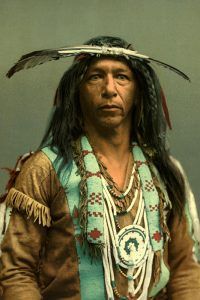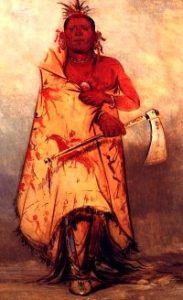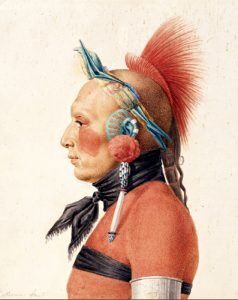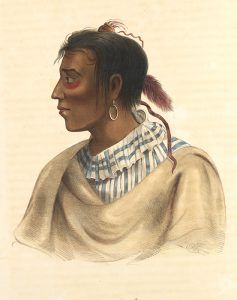Summaries: A B C D E-I J-K L-M N O P Q-R S T-V W X-Z
Occaneechi – The Occaneechi Tribe lived primarily on a large, four-mile-long Occoneechee Island and east of the confluence of the Dan and Roanoke Rivers in Virginia in the 17th century. Today they are known as the Occaneechi Band of Saponi Nation, living in North Carolina.
Oconee – This tribe belongs to the Muskogean linguistic stock. Early documents reveal at least two groups of Indians bearing the name Oconee who were probably related. One was on or near the coast of Georgia and seems later to have moved into the Apalachee country and become fused with the Apalachee tribe before the end of the 17th century. The others lived just below the Rock Landing on the Oconee River in Georgia. In about 1716, they moved to the east bank of the Chattahoochee in Stewart County, Georgia. A few years later, part of them went to the Alachua Plains, in the present Alachua County, Florida, where they became the nucleus of the Seminole Nation and furnished the chief to that people until the end of the Seminole war. Most of them were then taken to Oklahoma, but they had already lost their identity.
Ofo – Also called the Mosopelea tribe, these Siouan-speaking people historically inhabited the upper Ohio River. In reaction to Iroquois Confederacy invasions to control hunting grounds in the late 17th century, they moved south to the lower Mississippi River. Around 1700, French travelers reported Ofo villages in Louisiana on the Yazoo River. Refusing to join the Natchez in their war against the French in the 1710s and 1720s, the Ofo moved further south. They and other remnant peoples became assimilated into the Biloxi and Tunica peoples. Their language became extinct. Today their descendants are enrolled in the federally recognized Tunica-Biloxi Indian Tribe and have a reservation in Avoyelles Parish, Louisiana.
Ohlone/Costanoan – The Ohlone Indians, named Costanoan by early Spanish colonists, are a linguistic family who lived on the coast of central California.
Ojibwe – The Ojibwe and Chippewa are the same tribe but pronounced differently due to accents. Ojibwe is used in Canada, although the Ojibwe west of Lake Winnipeg are sometimes referred to as the Saulteaux. In the United States, Chippewa was used in all treaties and is the official name.
Okanagan – Calling themselves Syilx, this tribe is part of the Interior Salish ethnological and linguistic grouping. Their traditional territory spans the U.S.-Canada boundary in Washington state and British Columbia in the Okanagan Country region. At the height of Okanagan culture, about 3000 years ago, it is estimated that 12,000 people lived in this valley and surrounding areas. The Okanagan people employed an adaptive strategy, moving within traditional areas to fish, hunt, or collect food throughout the year. In the winter months, they lived in semi-permanent villages of kekulis, a type of pithouse. Descendants still live in both the United States and Canada.
Okelousa – Associated with the Muskhogean peoples, this tribe moved about considerably along the Mississippi River and the seacoast. They finally united with the Houma, the Acolapissa, or some other Muskhogean band on the lower Mississippi.
Omaha – The Omaha were a powerful Siouan nation living in Nebraska. Their name means “those going against the wind or current” and is sometimes shortened to Maha. The Omaha belonged to the Siouan linguistic stock, which also included the Ponca, Kansa, Osage, and Quapaw.
Onathaqua – The name of a tribe or village near Cape Canaveral on the eastern coast of Florida. They were in alliance with the Calusa tribe in the 16th Century. They spoke a language similar to Timucuan, which is related to Muskogean.
Onondaga – An important tribe of the Iroquois confederation, formerly living on the mountain, lake, and creek bearing their name, in the present-day Onondaga County, New York, and extending northward to Lake Ontario and southward to the Susquehanna River. Their name means “People of the Hills.” On November 11, 1794, the Onondaga Nation, along with the other Haudenosaunee nations, signed the Treaty of Canandaigua with the United States, in which their right to their homeland was acknowledged. Today, the nation is a member of the Haudenosaunee group of tribes, which have been united for several hundred years by complementary traditions, beliefs, and cultural values. Sometimes referred to as the Iroquois Confederacy or Six Nations, the Haudenosaunee originally consisted of the Mohawk, Oneida, Onondaga, Cayuga, and Seneca nations. The Tuscarora migrated from the south and peacefully joined the Confederacy in the early 11700s, bringing to six the number of nations united by Haudenosaunee traditional law. The present-day territory of the Onondaga Nation is approximately 7,300 acres just south of Syracuse, New York, with their tribal headquarters located at Nedrow, New York.
Osage – Of Siouan linguistic stock and Plains culture, the Osage were situated on the Osage River just south of the Missouri River in the western part of Missouri. However, they ranged as far as Arkansas, Kansas, and Oklahoma. The Winnebago/Ho-Chunk occasionally warred against them. They first came in contact with Europeans in the early 1700s and eventually allied themselves with the French against enemy tribes and later became scouts for the U. S. Army. Being rich in land, the Osage subsequently sold most of it to the American Government, from which came oil and mineral fees to the Osage. Today, the Osage Nation claims more than 10,000 members.
Oto, Otoe, OH toh – The Otoe were once part of the Siouan tribes of the Great Lakes region, commonly known as the Winnebago. However, they began to migrate southwest, where they were located just north of the Missouri River and west of the Mississippi River in what is now northern Missouri and Iowa. This group eventually split into at least three distinct tribes: the Ioway, Missouri, and the Otoe, who finally settled near the Platte River in southeastern Nebraska. Following the Louisiana Purchase, the Otoe were the first tribe encountered by the Lewis and Clark Expedition, meeting at a place known as Council Bluffs. In the earliest times, the Oto lived in villages and practiced farming, but eventually, they adopted the culture of the plains. In 1881 they moved to a reservation in Oklahoma with the Missouri. Today the Otoe-Missouria remain a federally recognized tribe based in Red Rock, Oklahoma.
Ottawa, Odawa – An Algonquian tribe, the Ottawa were closely related to the Anishinaabe and Potawatomi. The Ottawa and Ojibwe were part of a long-term alliance with the Potawatomi tribe, called the Council of Three Fires, and fought the Iroquois Confederacy and the Sioux. Today, most live in their original homeland in southern Ontario and Michigan, although some were relocated to Oklahoma by the US government and others assimilated into Ojibwe bands.
Ouachita – A former Caddoan tribe, the Ouachita resided on the Black or Ouachita River in northeast Louisiana. Jean-Baptiste Le Moyne de Bienville, a Louisiana colonizer, encountered them in 1700 encountered some of them carrying salt to the Taensa, with whom they intended to live. Later, when Bienville reached the main Ouachita village, he found about five houses holding 70 men. Sometime later, it is thought that the Ouachita Natchitoch and their identity was soon lost.
Summaries: A B C D E-I J-K L-M N O P Q-R S T-V W X-Z
Also See:
Native Americans – First Owners of America





